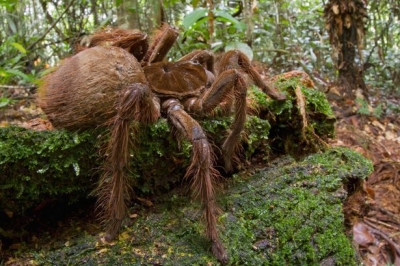
The Goliath birdeater tarantula from South America is the largest spider in the world. Weighing up to 170 gm, its legs can reach up to one foot. Hunting at night, its diet mainly comprises earthworms, insects and frogs.
The Goliath bird-eating tarantula lives in the rainforest regions of northern South America, including Venezuela, northern Brazil, Guyana, French Guiana and Suriname. It lives in the deep rainforest, in silk-lined burrows and under rocks and roots.
If they need to defend themselves, they rub hairs together to create a hissing noise loud enough to be heard 15 feet away. They can also let their hairs loose and fling them at attackers. The goliath bird-eating spider may also rear up on its hind legs to show its large fangs as a further defense strategy. If they need to defend themselves, they rub hairs together to create a hissing noise loud enough to be heard 15 feet away. They can also let their hairs loose and fling them at attackers. The goliath bird-eating spider may also rear up on its hind legs to show its large fangs as a further defense strategy.
After their maturation molt, males develop a “finger” on the underside of the first set of front legs that is used to hook and lock the female’s fangs and to steady themselves while they mate. After mating, males die within a few months.
The female must have recently molted in order to reproduce, or acquired sperm will be lost during the molt. Once mated, the female makes a web in which she lays 50 to 200 eggs that become fertilized as they pass out of her body. The female then wrap the eggs into a ball, and, unlike other species of tarantula, the female carries the egg sac with her. Egg sacs are almost the size of a tennis ball and contain around 70 spiderlings.
In order to grow, they must go through several molts. Molting is the process by which the tarantula sheds its old exoskeleton and emerges in a new, larger one. Spiderlings can be expected to molt five or six times in their first year. They take around two to three years to reach maturity.
Credit : Smithonian National Zoo
Picture Credit : Google




